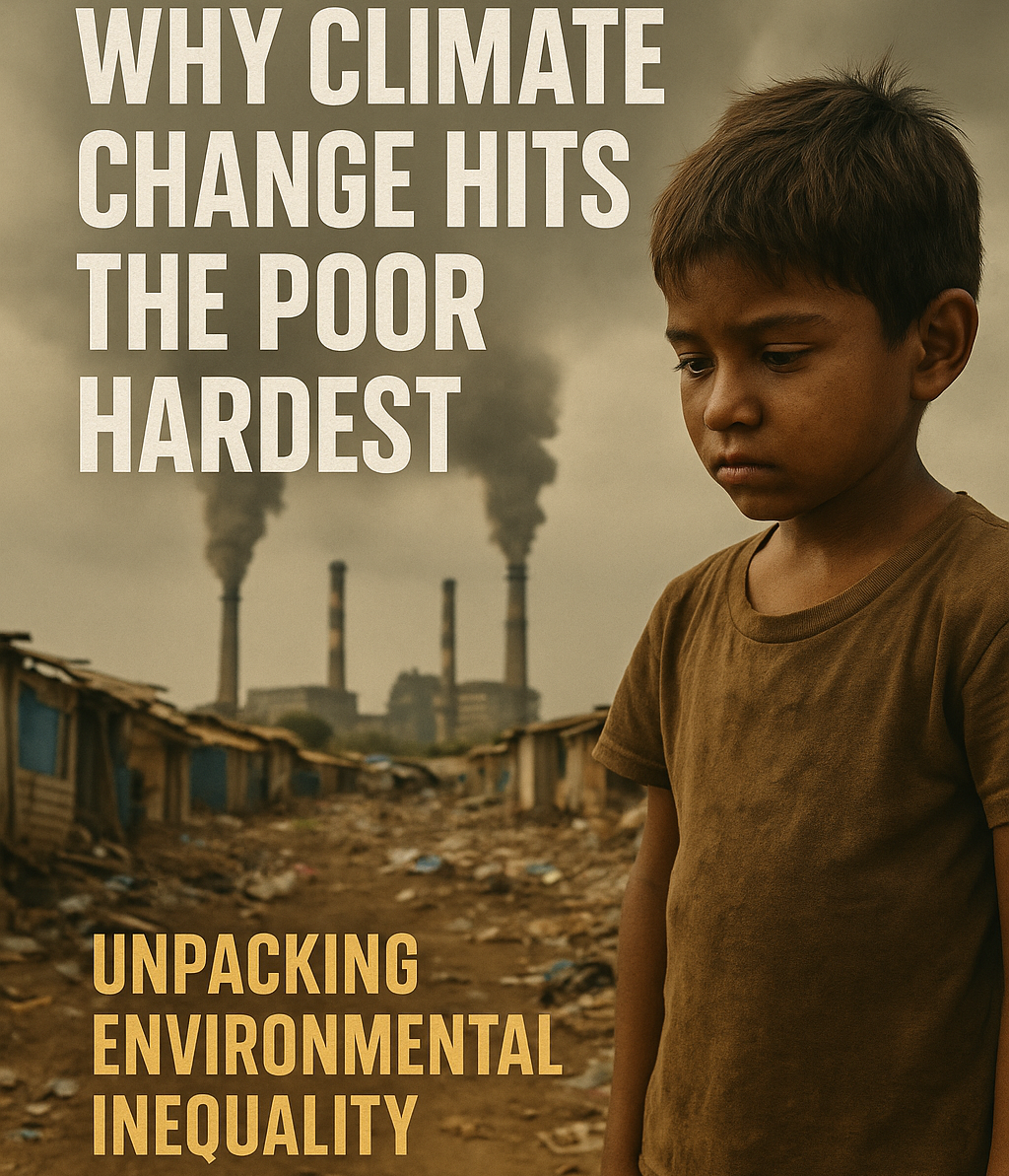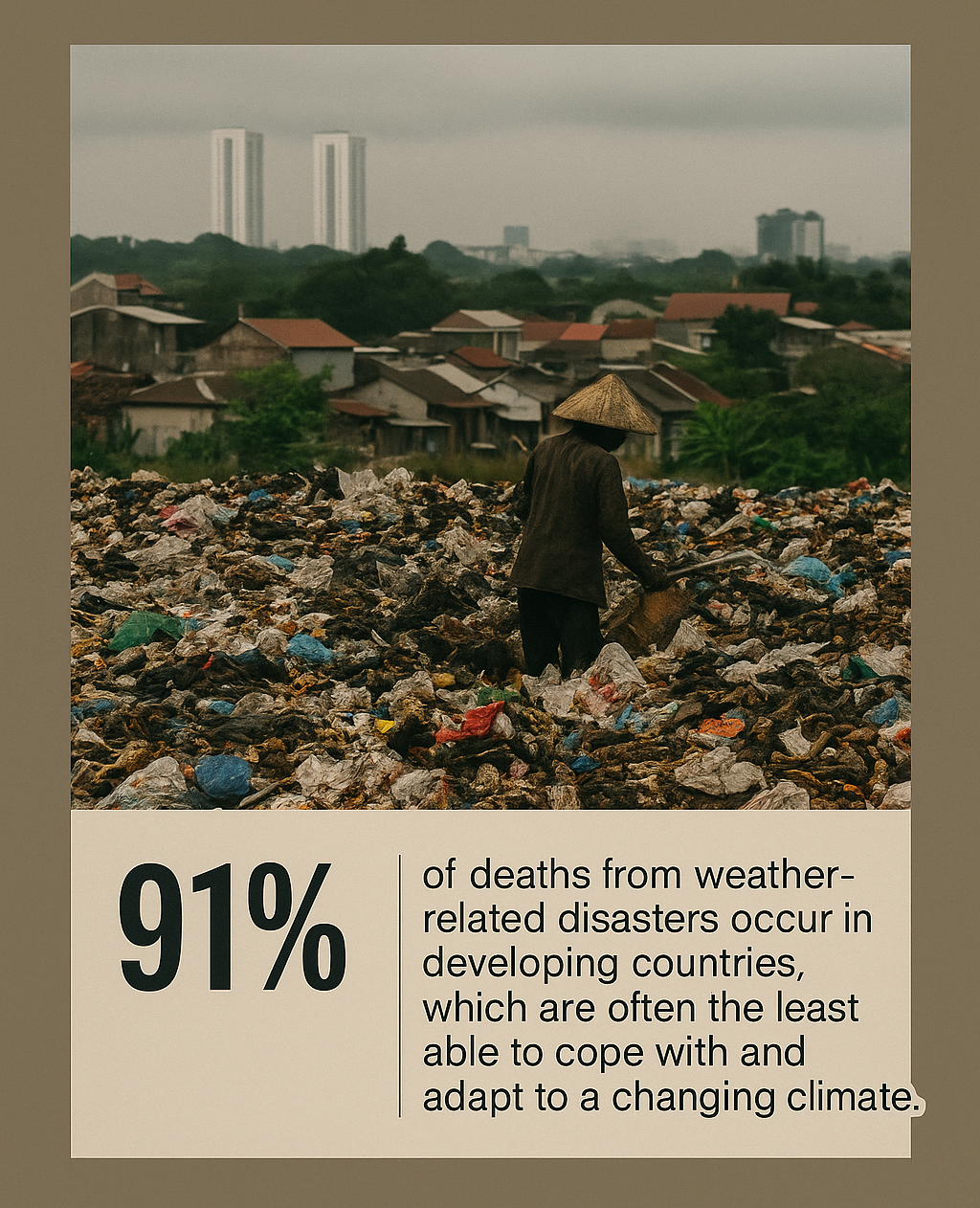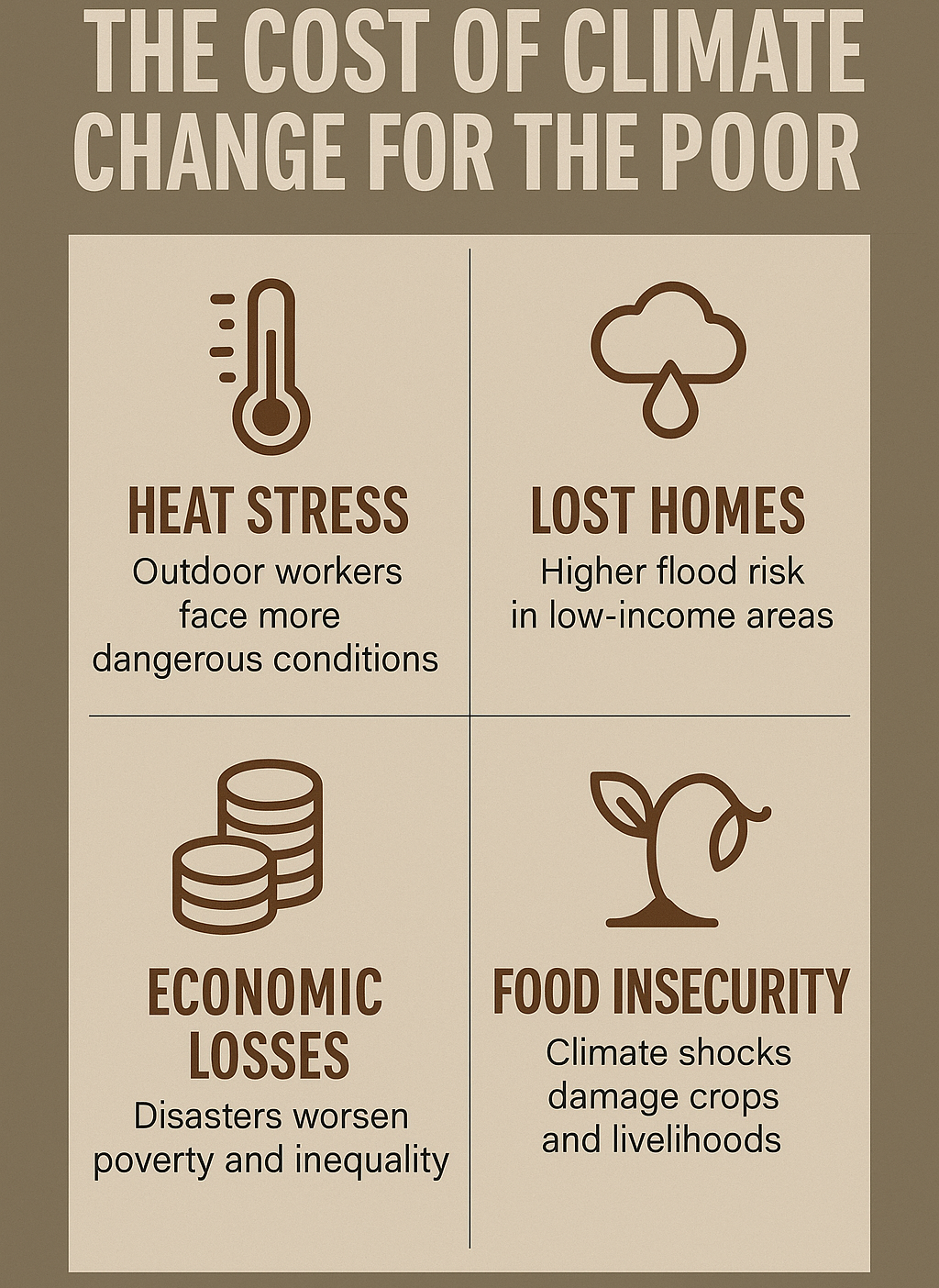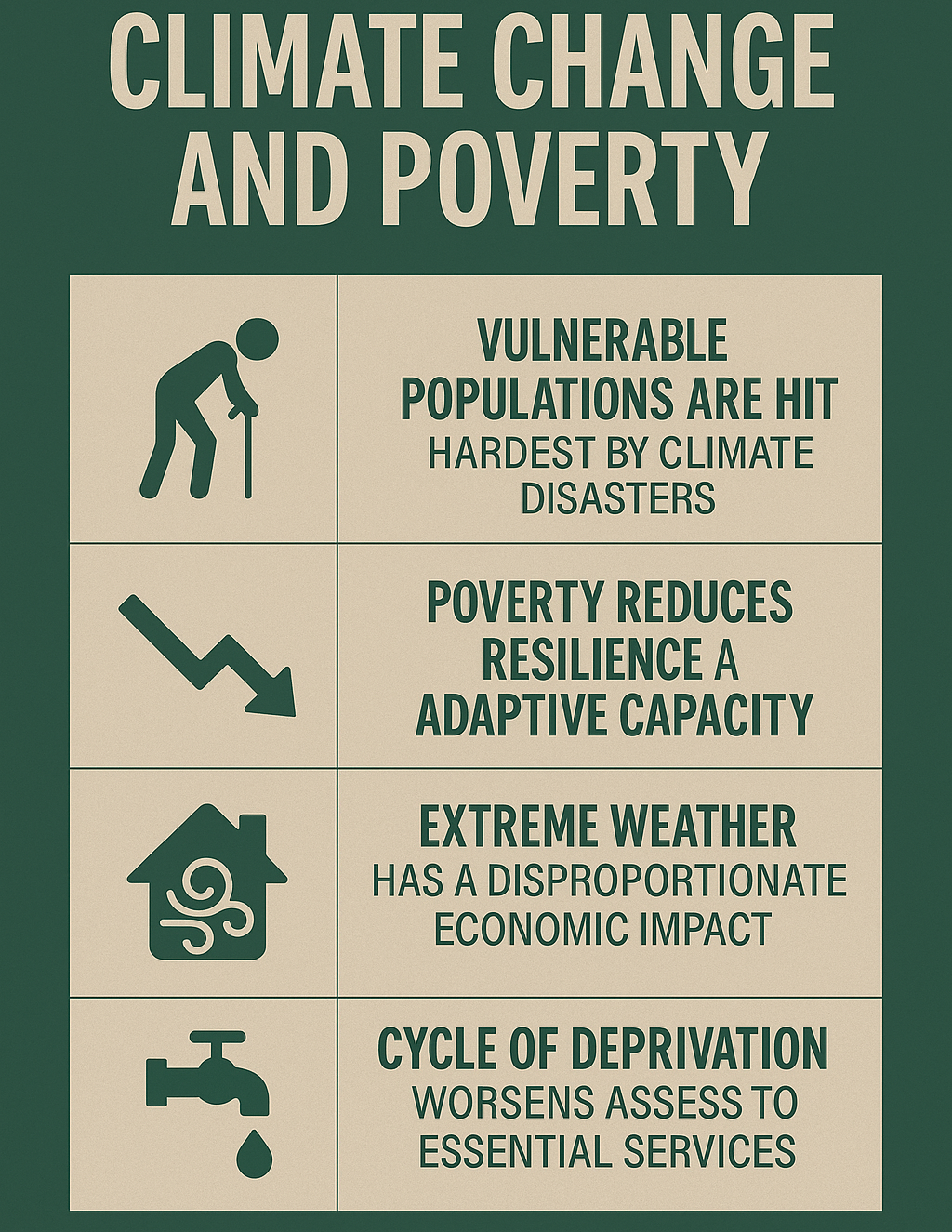Why Climate Change Hits the Poor Hardest: Unpacking Environmental Inequality
Explore how climate change disproportionately harms low-income & marginalized communities. Unpack environmental injustice, from climate displacement to pollution. Discover regenerative solutions & global calls for climate reparations. Read the deep dive into why climate change hits the poor hardest.

Written by Lavanya, Intern, Allegedly The News
NEW DELHI, July 31, 2025
The climate crisis, a global existential threat, does not impact all populations equally. While its consequences are far-reaching, a stark and undeniable truth emerges: it is the world's low-income and marginalized communities, those least responsible for historical emissions, who bear the disproportionate brunt of rising global temperatures. This isn't merely an unfortunate coincidence; it's a systemic injustice, a profound environmental inequality woven into the fabric of our societies.
The Unequal Burden of a Warming World: Exposing the Vulnerability Gap
The very essence of climate change, from escalating heatwaves to torrential floods, prolonged droughts to insidious sea-level rise, amplifies the already precarious existence of the poor. Imagine a family in a low-lying coastal village in Bangladesh, their modest homes already fragile, now facing relentless storm surges, the slow, insidious creep of saltwater inundation, and the destruction of their arable land. Or consider a smallholder farmer in rural India, reliant on unpredictable rain-fed agriculture, whose crops are repeatedly decimated by erratic monsoons or prolonged, punishing droughts, pushing them deeper into debt and food insecurity. These are not abstract scenarios concocted for dramatic effect; they are the harsh, daily realities for hundreds of millions across the globe.
Low-income communities often reside in areas inherently more susceptible to climate hazards due to a confluence of historical inequities, discriminatory urban planning and zoning laws, and a chronic lack of investment in resilient infrastructure. They possess severely limited financial buffers to rebuild after recurrent disasters, scant access to adequate healthcare to cope with climate-induced illnesses, and often lack the political leverage to effectively advocate for their urgent needs. This insidious combination perpetuates a vicious cycle of poverty and vulnerability, where each successive climate shock pushes them further into destitution, eroding their capacity to recover and adapt. A 2020 study published in Nature Communications highlighted that developing countries, despite contributing minimally to global emissions, face the greatest economic losses from climate impacts due to their limited adaptive capacities and high exposure to extreme weather events.
Disasters: Natural Phenomena or Systemic Injustice? A Deeper Look
When a category 5 hurricane devastates a coastal city or an unprecedented wildfire rages across a forested region, the prevalent media narrative frequently frames these events as "natural disasters." Yet, for marginalized communities, the impact is anything but naturally occurring. Consider the harrowing aftermath of Hurricane Katrina in New Orleans in 2005, where predominantly Black and low-income neighborhoods, many situated in flood-prone areas due to historical redlining, were almost entirely submerged. Their residents faced immense, systemic challenges in evacuation, rescue, and subsequent recovery efforts, starkly contrasting with the experiences of wealthier, predominantly white areas. Or, reflect on the recurring, devastating wildfires in California, where uninsured residents and those living in manufactured housing or older, less resilient structures, often located in the increasingly volatile wildland-urban interface, face catastrophic losses with severely limited recourse or recovery support.
These catastrophic events lay bare the profound fault lines of societal inequality. Pre-existing vulnerabilities such as dilapidated housing stock, severely limited access to emergency services, lack of transportation, and a higher prevalence of chronic health conditions transform what might be considered a "natural" climate extreme into a profound and undeniable injustice. The "natural" aspect of the disaster gives way to the "unjust" reality of who suffers the most, why they suffer disproportionately, and who is left behind in the recovery. As the UN Environment Programme (UNEP) stated, "Climate change impacts are disproportionately felt by the poorest and most vulnerable, deepening inequalities and leading to a vicious cycle of poverty and environmental degradation".

The Silent Crisis of Climate Displacement: A Global Migration
Climate change is undeniably creating a new and rapidly growing category of refugees: climate migrants. From low-lying island nations facing the existential threat of complete submersion to vast agricultural regions rendered uninhabitable by desertification and prolonged drought, millions are being forced from their ancestral homes, often with little warning or support. The World Bank's groundbreaking Groundswell report, released in 2021, shockingly estimated that by 2050, climate change could compel over 216 million people to move within their own countries across six regions: Sub-Saharan Africa, East Asia and the Pacific, South Asia, North Africa, Latin America, and Eastern Europe and Central Asia.
This displacement is not merely a logistical change of address; it represents a profound and often irreversible loss of livelihood, cultural identity, social networks, and community bonds. Displaced populations frequently end up in overcrowded urban centers, facing new forms of marginalization, intense competition for scarce resources, and, tragically, even increased risks of social unrest and conflict. The crisis of climate-induced displacement is an escalating humanitarian emergency that demands immediate, comprehensive, and sustained global attention, acknowledging the deep injustice of forcing people to flee lands they and their ancestors have stewarded for generations, often due to the emissions of distant, industrialized nations.
Unmasking Environmental Racism: The Shadow of Pollution and Zoning Laws
The burden of environmental harm extends far beyond the direct impacts of climate change; it encompasses a pervasive pattern of historical injustice. For decades, communities of color and low-income populations have been systematically targeted as preferred sites for polluting industries, hazardous waste disposal facilities, and other environmentally detrimental infrastructure. This insidious phenomenon, widely recognized as environmental racism, is a direct consequence of discriminatory zoning laws, redlining policies, and systemic decisions that have historically relegated marginalized groups to areas with cheaper land values and significantly fewer political protections.
From the infamous "Cancer Alley" in Louisiana, where a dense cluster of petrochemical plants lines the Mississippi River, releasing a cocktail of toxic chemicals into predominantly Black communities, to urban neighborhoods in every major city choked by vehicular emissions, industrial effluence, and the particulate matter from nearby factories, these communities face a constant, cumulative assault on their health and well-being. Air pollution, contaminated water sources, and soil toxicity contribute directly to significantly higher rates of asthma, cancer, birth defects, and other chronic diseases among these populations. These devastating health disparities are not random occurrences; they are the direct and calculated consequence of systemic decisions that consistently prioritize corporate profit and industrial convenience over the fundamental human right to a clean and healthy environment for all, especially for those with the least power to resist. A landmark study by the National Academies of Sciences, Engineering, and Medicine confirmed in 2021 that communities of color and low-income communities face disproportionate exposure to pollution in the United States.
Health Under Siege: The Triple Threat of Air, Heat, and Contaminated Water
The health impacts of climate change are manifold, complex, and consistently fall most heavily on already at-risk populations. Prolonged and intensifying heatwaves, exacerbated by the urban heat island effect in densely populated, concrete-heavy neighborhoods lacking green spaces, pose a severe and often lethal threat to the elderly, outdoor laborers, and those without access to reliable air conditioning or cooling centers. Respiratory illnesses, already prevalent in polluted areas, are dramatically exacerbated by increased ground-level ozone, particulate matter from more frequent and intense wildfires, and higher concentrations of allergens. Contaminated water sources, resulting from a combination of severe floods overflowing sewage systems, prolonged droughts leading to water scarcity and poor sanitation, and industrial runoff, directly lead to outbreaks of waterborne diseases, malnutrition, and other acute health crises.
These health crises are further compounded by pre-existing chronic health conditions prevalent in marginalized communities (often linked to poverty and pollution exposure), limited access to quality healthcare services, and inadequate public health infrastructure that struggles to respond to escalating demand. The cycle is grim and self-perpetuating: climate change degrades environmental quality, leading to a cascade of public health crises, which in turn further strain already vulnerable populations and overstretched healthcare systems, perpetuating a cycle of illness and increased vulnerability. The World Health Organization (WHO) estimates that between 2030 and 2050, climate change is expected to cause approximately 250,000 additional deaths per year from malnutrition, malaria, diarrhea, and heat stress alone.

The Vanguard of Change: Regenerative Solutions and Indigenous Wisdom
Amidst the often-grim realities of climate impact, there is immense, vibrant hope in the innovative and deeply rooted solutions emerging from communities on the very front lines of climate change. Regenerative farming practices, which prioritize soil health, enhance biodiversity, and promote significant carbon sequestration, offer a powerful and necessary antidote to the destructive footprint of industrial agriculture. These methods, frequently rooted in Traditional Ecological Knowledge (TEK) meticulously passed down through countless generations of indigenous communities, are proving to be remarkably effective in building profound climate resilience, enhancing local food security, and actively restoring degraded ecosystems.
Indigenous peoples, despite being disproportionately affected by climate change due to their deep connection to the land and reliance on natural resources, hold invaluable, millennia-old wisdom about living in profound harmony with nature. Their traditional land management practices, nuanced understanding of local ecosystems, and holistic, reciprocal worldviews are now widely recognized as absolutely critical for developing truly sustainable, equitable, and effective climate solutions. From carefully controlled burns that prevent catastrophic wildfires to sophisticated agroforestry systems that mimic natural forest ecosystems, indigenous knowledge is not merely a relic of the past but a dynamic, evolving body of wisdom actively guiding cutting-edge environmental solutions and offering pathways to ecological restoration and community well-being.
The Circular Economy: A Path to Resilience and Empowerment
Moving decisively beyond the unsustainable, linear "take-make-dispose" economic model that has dominated industrial societies, the concept of a circular economy offers a transformative and hopeful approach to building profound climate resilience. By meticulously designing out waste and pollution from the outset, by keeping products and valuable materials in use for as long as possible, and by actively regenerating natural systems, circular models drastically reduce our collective reliance on finite virgin resources and minimize our overall environmental impact.
For vulnerable communities, the principles of a circular economy can translate directly into tangible, local initiatives that create meaningful jobs, significantly reduce the oppressive burden of waste management, and foster genuine self-sufficiency. Community-based repair cafes, localized recycling and upcycling initiatives that add value to discarded materials, and systems that prioritize reuse, sharing, and resource efficiency can directly empower residents, dramatically reduce their exposure to local pollution, and build more robust, resilient, and equitable local economies. The Ellen MacArthur Foundation champions this model, demonstrating its potential for significant carbon emission reductions and economic benefits.
Justice in the Courts: Climate Lawsuits on the Frontline of Change
The urgent fight for environmental justice is increasingly being waged with tenacity and strategic brilliance in courtrooms around the world. Major climate lawsuits are emerging as powerful and necessary tools to hold governments and powerful corporations accountable for their historical and ongoing contributions to climate change and the resulting devastating harm inflicted upon vulnerable communities. Cases brought by courageous youth activists, resilient indigenous groups, and steadfast frontline communities are pushing aggressively for stronger, legally binding climate policies, demanding fair compensation for incurred damages, and challenging the very legality of continued fossil fuel expansion and new polluting infrastructure.
For instance, the landmark Juliana v. United States case, initiated by a group of young Americans, argues compellingly that the U.S. government has violated their constitutional rights by failing to adequately address climate change and protect future generations. Similarly, in the Netherlands, the Urgenda Foundation v. State of the Netherlands case successfully compelled the Dutch government to reduce greenhouse gas emissions by a specific target. While these legal battles are often protracted, complex, and challenging, they represent a crucial and growing front in the environmental justice movement, forcing a long-overdue reckoning with historical injustices and actively paving the way for legally mandated, ambitious climate action. The Sabin Center for Climate Change Law at Columbia University tracks hundreds of such cases globally, highlighting the growing trend of climate litigation as a tool for justice.
The Demand for Reparations: A Loud Call for Historical Justice
A powerful and increasingly vocal chorus of voices, particularly from nations in the Global South, is demanding climate reparations. This fundamental call for rich, industrialized nations, those historically responsible for the vast majority of cumulative greenhouse gas emissions since the Industrial Revolution, to financially compensate poorer, developing nations for centuries of environmental harm and the ongoing, devastating impacts of climate change, is deeply rooted in principles of historical justice, equity, and moral responsibility.
Developing nations, already grappling with pervasive poverty, chronically limited infrastructure, and pre-existing societal vulnerabilities, are facing escalating and immense costs from climate-induced disasters and the urgent need for comprehensive adaptation measures. They argue with compelling moral authority that those who benefited most from unchecked industrialization and the relentless consumption of fossil fuels should now bear the commensurate financial responsibility for the resulting climate crisis. While complex, multifaceted, and often contentious, the concept of climate reparations, increasingly framed as "loss and damage" funding, is gaining significant traction as a fundamental component of global climate justice negotiations, acknowledging that true and lasting solutions require a profound reckoning with, and active redress of, historical imbalances and injustices.

Beyond Greenwashing: Identifying Authentic Climate Solutions in a Sea of PR Stunts
In the wake of rapidly growing global climate awareness and increasing consumer demand for sustainability, many corporations engage in a deceptive practice known as "greenwashing." This involves marketing tactics that egregiously exaggerate or deliberately misrepresent their environmental efforts to appear far more sustainable or eco-friendly than they genuinely are. This widespread practice can severely mislead well-intentioned consumers and, more dangerously, divert crucial attention and resources away from truly genuine, impactful, and systemic climate solutions.
Identifying authentic climate solutions in a landscape saturated with corporate spin requires critical scrutiny and an informed perspective. Look for companies and initiatives that demonstrate radical transparency in their reporting, possess verifiable third-party certifications (e.g., B Corp, Fair Trade, organic certifications), set ambitious and measurable environmental targets (e.g., science-based targets for emission reductions), and adopt a truly systemic approach to sustainability that integrates environmental responsibility throughout their entire value chain, from raw material sourcing to product end-of-life. True eco-efforts prioritize genuinely reducing environmental harm, investing in regenerative practices, and actively empowering communities, rather than simply offering superficial "green" branding or token gestures. Be wary of vague claims, a lack of data, or a focus on small, isolated initiatives while core business practices remain unsustainable.
What Happens Next? A Path Towards Climate Justice
The unfolding narrative of environmental inequality and climate change is one of immense and daunting challenge, but also one of profound and transformative opportunity. The disproportionate burden on low-income and marginalized communities unequivocally demands urgent, intersectional solutions that meticulously address both the immediate symptoms and the deep-seated root causes of climate injustice. Moving forward, a truly concerted and collaborative effort is critically needed from all stakeholders:
- Policy and Governance: Governments worldwide must enact and rigorously enforce equitable and ambitious climate policies. This includes robust, legally binding emission reduction targets, substantial and accessible adaptation funding for vulnerable nations (especially through mechanisms like the Loss and Damage Fund agreed at COP27), and strict regulations that actively prevent and remediate environmental racism and pollution hotspots.
- Economic Transformation: A rapid, just, and equitable transition to regenerative and circular economic models is absolutely essential. This transformation must prioritize fostering localized resilience, creating green jobs, ensuring food sovereignty, and implementing sustainable resource management practices that benefit all, not just a privileged few.
- Technological Innovation: While not a singular panacea, responsible technological advancements in renewable energy, sustainable agriculture, advanced climate modeling, and resilient infrastructure must be developed. Crucially, these innovations must be equitably deployed and made accessible to all, especially those most in need and often furthest from technological access.
- Community Empowerment: Supporting, empowering, and amplifying the voices and courageous leadership of frontline and indigenous communities is paramount. Their traditional knowledge, lived experiences, and innovative local solutions offer invaluable insights into truly effective, culturally appropriate, and deeply sustainable climate actions.
- Accountability and Justice: Robust legal frameworks must be strengthened globally to hold major polluters, both corporations and complicit governments, accountable for their contributions to climate change. Furthermore, the global conversation around climate reparations and "loss and damage" must move beyond rhetoric towards concrete, actionable mechanisms to address historical injustices and support climate-vulnerable nations.
- Individual and Collective Action: While systemic change is undeniably the cornerstone, individual choices, from conscious consumption and supporting ethical businesses to actively advocating for local climate action and engaging in civic participation, can contribute powerfully to the broader, unstoppable movement for environmental justice.
The fight for climate justice is intrinsically, inextricably linked to the fight for social justice. It is a profound call to dismantle deeply entrenched systemic inequities, to recognize the inherent dignity and value of all lives, and to collectively build a world where environmental well-being is a fundamental human right, not a precarious privilege accessible only to a select few.
The Intersectional Vulnerability Thesis
The "Intersectional Vulnerability Thesis" posits that the disproportionate and often devastating impact of climate change on certain populations is not solely due to isolated factors such as their economic status or geographic location. Rather, it is the complex, compounding interplay of multiple, overlapping social identities and historical disadvantages, including race, class, gender, indigeneity, disability status, and colonial legacies. These intersecting vulnerabilities create compounded risks, multiply exposures to hazards, and severely limit adaptive capacities, making marginalized communities uniquely susceptible to climate shocks and tragically exacerbating existing inequalities. Addressing climate change effectively thus requires profoundly intersectional solutions that dismantle these interlocking systems of oppression, recognizing that true climate resilience is built on social justice.
An Interrogative Look: Beyond the Obvious
Could the current global financial architecture, heavily reliant on debt and often dictating austerity measures in developing nations, inadvertently deepen climate vulnerability by limiting their capacity to invest in adaptation and resilience? What role do international trade agreements play in perpetuating environmental inequality, often prioritizing commodity extraction in the Global South without sufficient environmental and social safeguards? And how can we effectively bridge the knowledge gap between scientific climate models and the experiential, traditional ecological knowledge of frontline communities to co-create more holistic and effective adaptation strategies?
Sources
Nature Communications, reports from The World Bank, UN Environment Programme (UNEP), National Academies of Sciences, Engineering, and Medicine, World Health Organization (WHO), United Nations Development Programme (UNDP), and organizations like the Ellen MacArthur Foundation and Sabin Center for Climate Change Law, along with environmental justice advocacy groups.




